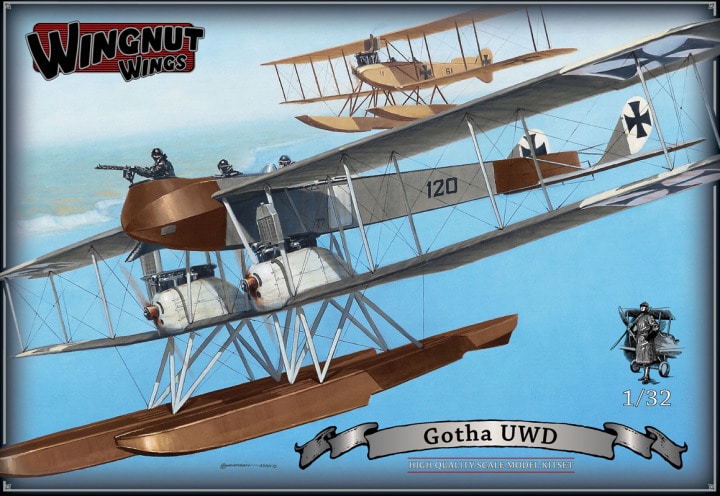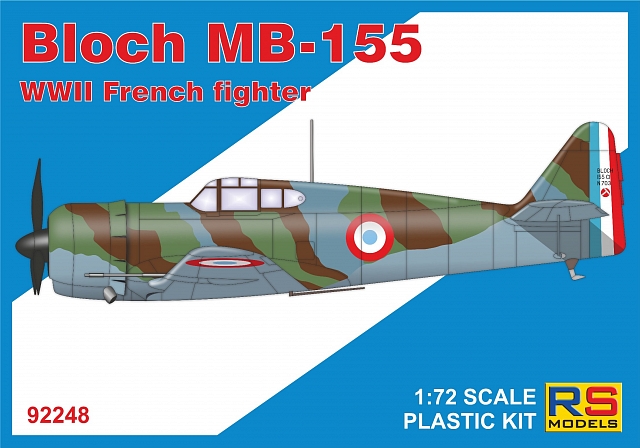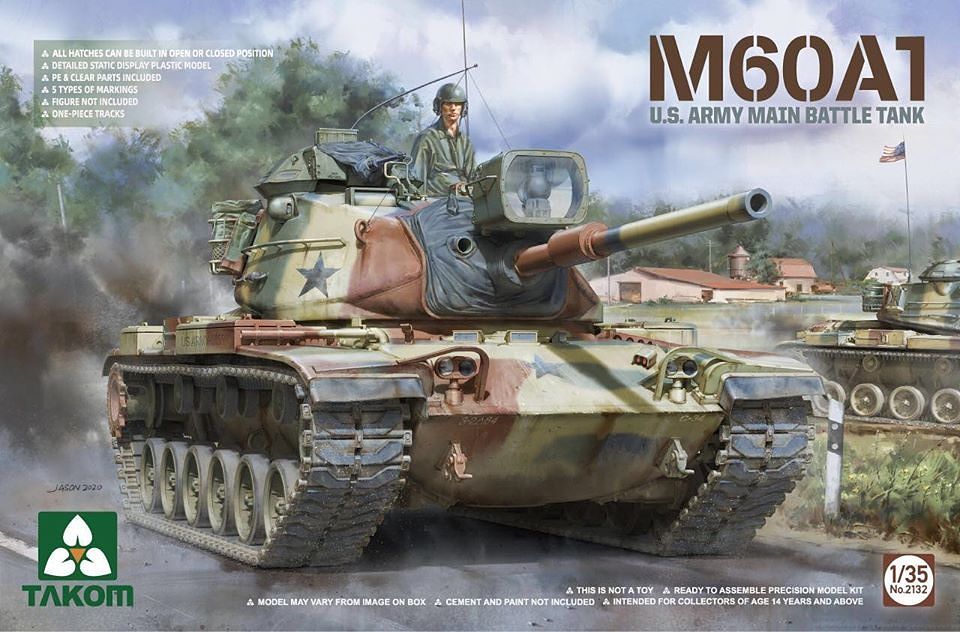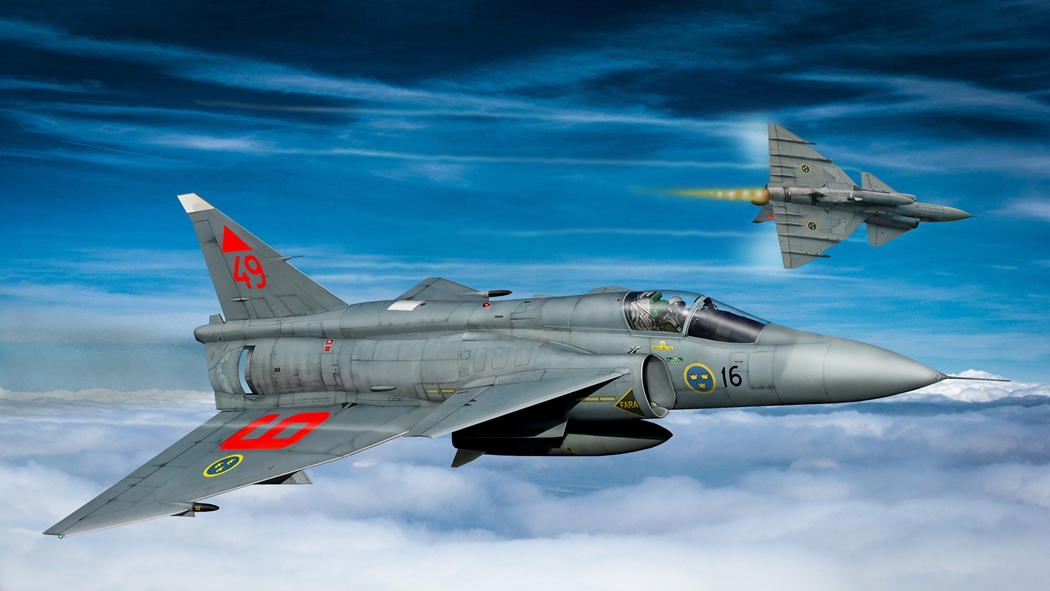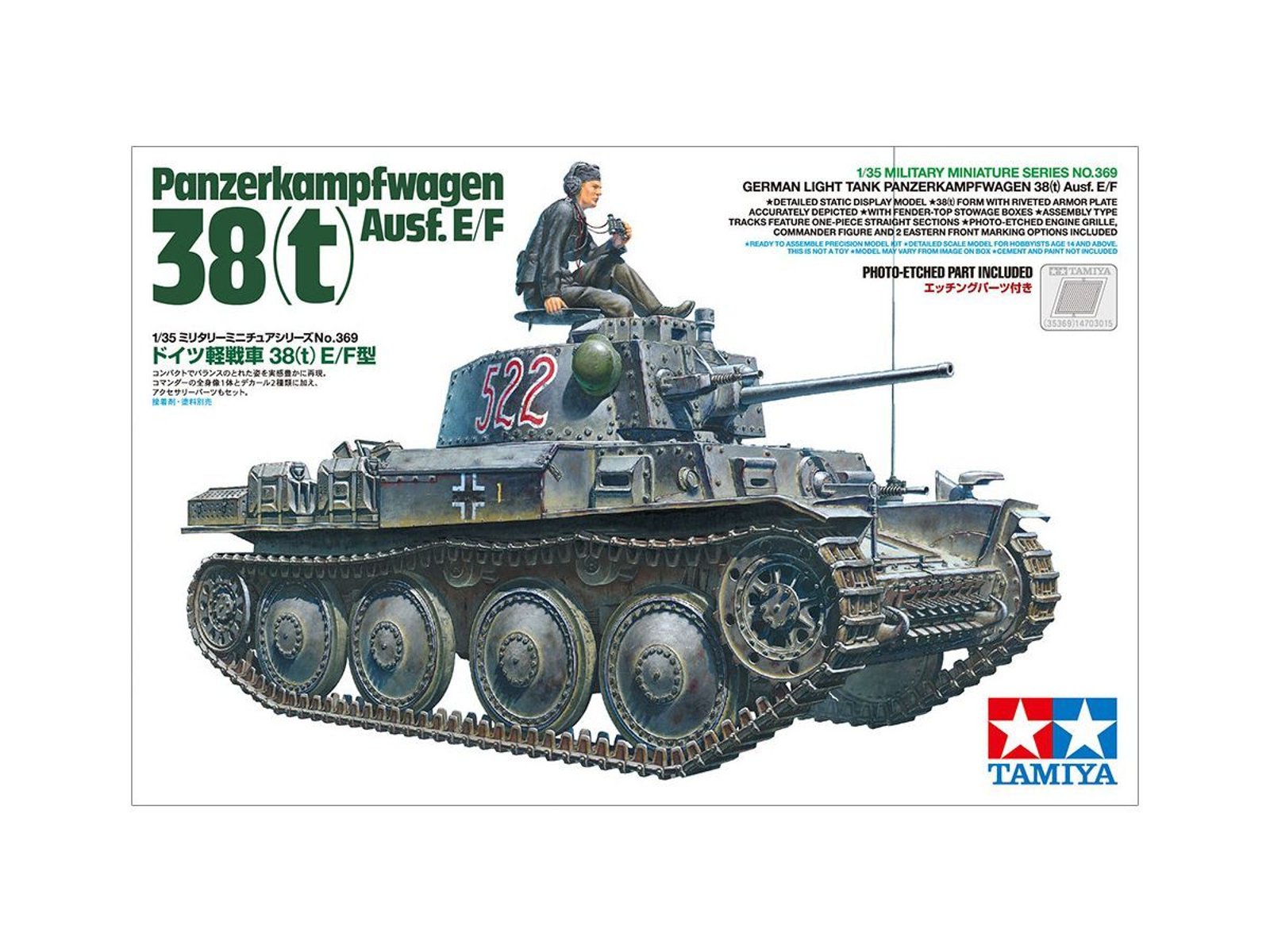Hračky
Celkem 1538 produktů
1/32 Gotha UWD. Highly detailed plastic Model kit with PE parts to build a planeScale 1:32not built/painted The unique Gotha UWD was one of several different twin engine seaplanes ordered by the German Navy to fit their requirements for a long range reconnaissance and torpedo carrying aircraft (although there is no evidence to suggest it was ever armed with a torpedo). The Gotha UWD was developed from the G.1 land plane and was completed in December 1915. It was described as easy to fly, able to take to the air with ease and was smooth on landing. In a preview of things to come, Gotha UWD 120 was used to bomb England during early 1916. -274 high-quality injection moulded plastic parts. -4 photo-etched metal detail parts. -2x Daimler-Mercedes 160hp D.III engines. -63cm wingspan. -10kg Carbonit bombs & bomb dropping ‘proboscis’, counter rotating propellers and optional map & document case and camera. -24 page fully illustrated instruction manual. -High quality Cartograf decals for Gotha UWD 120 which served with See Flieger Abteilung 1 in 1916
Plastikový model letadla 1/72 Caudron C-445/448 4 decal v. for France, Spain. Caudron C-455 was a conventionally configured low-wing cantilever monoplane with tailwheel undercarriage. The main undercarriage units retracted into the engine nacelles. Construction was wooden throughout, with wooden skinning everywhere but the forward and upper fuselage sections, which were skinned in metal. As usually configured, the cabin seated six passengers with baggage compartments fore and aft, and a toilet aft. 4 decal variants1. Caudron 448 Goéland, N°7272 F-AOMX, Course Paris-Saïgon, 1936 2. Caudron 445 Goéland, N°8712, GC I/55, France, June 1940 3. Caudron 445 Goéland, 2T-11, Mouzaiaville, Algeria, June 1944 4. Caudron 448 Goéland, N°7272, ex. F-AOMX, Grupo de Caza 26, 1937
Plastikový model letadla 1/72 Caudron C-445/448 4 decal v. for France, Spain. Caudron C-455 was a conventionally configured low-wing cantilever monoplane with tailwheel undercarriage. The main undercarriage units retracted into the engine nacelles. Construction was wooden throughout, with wooden skinning everywhere but the forward and upper fuselage sections, which were skinned in metal. As usually configured, the cabin seated six passengers with baggage compartments fore and aft, and a toilet aft. 4 decal variants1. Caudron 448 Goéland, N°7272 F-AOMX, Course Paris-Saïgon, 1936 2. Caudron 445 Goéland, N°8712, GC I/55, France, June 1940 3. Caudron 445 Goéland, 2T-11, Mouzaiaville, Algeria, June 1944 4. Caudron 448 Goéland, N°7272, ex. F-AOMX, Grupo de Caza 26, 1937
1/72 Bf 109G-6 Wheel set (smooth and ribbed tyres). This set has been designed for the new Tamiya Bf 109G-6 model and contains two pairs of the mainwheels with their axle mounts matching the specific Tamiya leg parts. The wheels offer two styles of the tread, one being smooth and the other with the distinctive ribbed pattern. The tyres are weighted Country of origin: Germany / WWII
1/72 Bf 109G-6 Wheel set (smooth and ribbed tyres). This set has been designed for the new Tamiya Bf 109G-6 model and contains two pairs of the mainwheels with their axle mounts matching the specific Tamiya leg parts. The wheels offer two styles of the tread, one being smooth and the other with the distinctive ribbed pattern. The tyres are weighted Country of origin: Germany / WWII
Plastikový model letadla 1/72 Bloch MB-155 5 decal v. for France, Luftwaffe. The Bloch MB.152 proved the definitive production model with nearly 500 produced. This version was powered by a Gnome-Rhone 14N-25/-49 series air cooled radial piston engine outputting at 1,100 horsepower depending on fitting. This was coupled to a three-bladed variable fixed propeller assembly. The combination supplied the aircraft with a top speed of 316 miles per hour with a range of 370 miles and service ceiling of 32,800 feet. 5 decal variants1. MB-155, No. 703, GC-1, Lt. Lefeuvre, Toulouse, June 19402. MB-155, No. 700, first prototype, France, December 19393. MB-155, No. 704, CO of 1 Escadrille, Capt. Coutaud, Agen, Algeria, June 19404. MB-155, No. 708, GC II/8, Vichy France Air-Force, 19415. MB-155, JG103, Luftwaffe, France 1943
Plastikový model letadla 1/72 Bloch MB-155 5 decal v. for France, Luftwaffe. The Bloch MB.152 proved the definitive production model with nearly 500 produced. This version was powered by a Gnome-Rhone 14N-25/-49 series air cooled radial piston engine outputting at 1,100 horsepower depending on fitting. This was coupled to a three-bladed variable fixed propeller assembly. The combination supplied the aircraft with a top speed of 316 miles per hour with a range of 370 miles and service ceiling of 32,800 feet. 5 decal variants1. MB-155, No. 703, GC-1, Lt. Lefeuvre, Toulouse, June 19402. MB-155, No. 700, first prototype, France, December 19393. MB-155, No. 704, CO of 1 Escadrille, Capt. Coutaud, Agen, Algeria, June 19404. MB-155, No. 708, GC II/8, Vichy France Air-Force, 19415. MB-155, JG103, Luftwaffe, France 1943
1/35 M60A1 Patton U.S. Army Main Battle Tank. The M60 is a main battle tank developed by the United States as a successor to the M46, M47, and M48 in order to combat the new T-54A tank fielded by the Soviet Union. The M60A1 tank is an improved mass-produced version of the M60, with production beginning in 1960, four years after the prototype of the original M60 was completed. The turret was changed from the M60's "turtleshell" shape to a thicker shape with front armor and a wider internal volume. The tank's excellent maneuverability, powerful engine and 105mm tank gun L7A1 made it an excellent tank with a good balance of offense and defense; it has become the standard main battle tank for the U.S. military and other Western countries. About 20,000 of this tank have been made, and it has become the best-selling tank. Takom's kit features a main hatch that opens and closes after assembly, with crawler belt tracks, clear and photo-etched parts, and markings for five versions. Please note that figures are not included. [Includes]: Clear parts, photo-etched parts, markings for 5 versions
1/35 M60A1 Patton U.S. Army Main Battle Tank. The M60 is a main battle tank developed by the United States as a successor to the M46, M47, and M48 in order to combat the new T-54A tank fielded by the Soviet Union. The M60A1 tank is an improved mass-produced version of the M60, with production beginning in 1960, four years after the prototype of the original M60 was completed. The turret was changed from the M60's "turtleshell" shape to a thicker shape with front armor and a wider internal volume. The tank's excellent maneuverability, powerful engine and 105mm tank gun L7A1 made it an excellent tank with a good balance of offense and defense; it has become the standard main battle tank for the U.S. military and other Western countries. About 20,000 of this tank have been made, and it has become the best-selling tank. Takom's kit features a main hatch that opens and closes after assembly, with crawler belt tracks, clear and photo-etched parts, and markings for five versions. Please note that figures are not included. [Includes]: Clear parts, photo-etched parts, markings for 5 versions
1/48 SAAB JA37 Viggen fighter. The JA37 Viggen was a Swedish medium-heavy fighter with a secondary role as attack aircraft. It was manufactured by Saab AB. The fighter version of the Viggen was the most common and recently developed of the Viggen variants. The first JA 37 Viggen was flown in 1974 and was rebuilt AJ37 Viggen with RM8A engines. The kit is CAD-produced and injection moulded. Markings for both the gray/gray livery and the intricate splinter camo are included.
1/48 SAAB JA37 Viggen fighter. The JA37 Viggen was a Swedish medium-heavy fighter with a secondary role as attack aircraft. It was manufactured by Saab AB. The fighter version of the Viggen was the most common and recently developed of the Viggen variants. The first JA 37 Viggen was flown in 1974 and was rebuilt AJ37 Viggen with RM8A engines. The kit is CAD-produced and injection moulded. Markings for both the gray/gray livery and the intricate splinter camo are included.
1/72 KDA-2 type 88-2 scout. The Beriev Be-8 (USAF/DoD reporting name “Type 33”, NATO reporting name “Mole”), was built by the Soviet Beriev OKB in 1947. It was a passenger/liaison amphibian aircraft with a layout similar to the Be-4 but substantially larger and heavier. It was a single engine parasol with the wing installed on a thin pylon and a pair of short struts. Compared to the Be-4, the Be-8 was equipped with retractable landing gear, and pilot and passenger cabins had heating utilizing engine heat. The Be-8 was intended as a civil aircraft and carried no armament. First flight was on December 3, demonstrating good performance. Two experimental aircraft were built, and one was demonstrated during 1951 Soviet Aviation Day at Tushino.One of Be-8 was equipped with hydrofoils, developed at TsAGI. These “Underwater Wings” were installed on landing gear struts and pushed aircraft above the water well before it could be done by the wing lift force. As a result, takeoff was much easier and imposed less punishment on the hull from the waves. Despite very effective during takeoff hydrofoils had negative impact on flight speed. Construction of retractable hydrofoils was not ready, and the concept did not find practical applications.
1/72 BHU-6B / UF-2 "Albatross" (Japan Maritime Self-Defense Force). The Beriev Be-8 (USAF/DoD reporting name “Type 33”, NATO reporting name “Mole”), was built by the Soviet Beriev OKB in 1947. It was a passenger/liaison amphibian aircraft with a layout similar to the Be-4 but substantially larger and heavier. It was a single engine parasol with the wing installed on a thin pylon and a pair of short struts. Compared to the Be-4, the Be-8 was equipped with retractable landing gear, and pilot and passenger cabins had heating utilizing engine heat. The Be-8 was intended as a civil aircraft and carried no armament. First flight was on December 3, demonstrating good performance. Two experimental aircraft were built, and one was demonstrated during 1951 Soviet Aviation Day at Tushino.One of Be-8 was equipped with hydrofoils, developed at TsAGI. These “Underwater Wings” were installed on landing gear struts and pushed aircraft above the water well before it could be done by the wing lift force. As a result, takeoff was much easier and imposed less punishment on the hull from the waves. Despite very effective during takeoff hydrofoils had negative impact on flight speed. Construction of retractable hydrofoils was not ready, and the concept did not find practical applications.
1/72 BHU-6B / UF-2 "Albatross" (Japan Maritime Self-Defense Force). The Beriev Be-8 (USAF/DoD reporting name “Type 33”, NATO reporting name “Mole”), was built by the Soviet Beriev OKB in 1947. It was a passenger/liaison amphibian aircraft with a layout similar to the Be-4 but substantially larger and heavier. It was a single engine parasol with the wing installed on a thin pylon and a pair of short struts. Compared to the Be-4, the Be-8 was equipped with retractable landing gear, and pilot and passenger cabins had heating utilizing engine heat. The Be-8 was intended as a civil aircraft and carried no armament. First flight was on December 3, demonstrating good performance. Two experimental aircraft were built, and one was demonstrated during 1951 Soviet Aviation Day at Tushino.One of Be-8 was equipped with hydrofoils, developed at TsAGI. These “Underwater Wings” were installed on landing gear struts and pushed aircraft above the water well before it could be done by the wing lift force. As a result, takeoff was much easier and imposed less punishment on the hull from the waves. Despite very effective during takeoff hydrofoils had negative impact on flight speed. Construction of retractable hydrofoils was not ready, and the concept did not find practical applications.
1/72 KDA-2 type 88 light bomber. The Beriev Be-8 (USAF/DoD reporting name “Type 33”, NATO reporting name “Mole”), was built by the Soviet Beriev OKB in 1947. It was a passenger/liaison amphibian aircraft with a layout similar to the Be-4 but substantially larger and heavier. It was a single engine parasol with the wing installed on a thin pylon and a pair of short struts. Compared to the Be-4, the Be-8 was equipped with retractable landing gear, and pilot and passenger cabins had heating utilizing engine heat. The Be-8 was intended as a civil aircraft and carried no armament. First flight was on December 3, demonstrating good performance. Two experimental aircraft were built, and one was demonstrated during 1951 Soviet Aviation Day at Tushino.One of Be-8 was equipped with hydrofoils, developed at TsAGI. These “Underwater Wings” were installed on landing gear struts and pushed aircraft above the water well before it could be done by the wing lift force. As a result, takeoff was much easier and imposed less punishment on the hull from the waves. Despite very effective during takeoff hydrofoils had negative impact on flight speed. Construction of retractable hydrofoils was not ready, and the concept did not find practical applications.
1/35 Panzerkampfwagen 38(t) Ausf.E/F. This is an injection-plastic military vehicle model kit. From Tamiya: After the effective annexation of Czechoslovakia by Nazi Germany in 1939, German forces were interested enough in the native Czech LTvz38 light tank that they took it on and ordered production under their own categorization of 38(t), a light tank with riveted, welded armor and a perky 3.7cm gun. Early production 38(t)s took part in the early German offensives of the war, and the 38(t) underwent continued development with 1,400 produced in total. Ausf.E and F 38(t)s had additional armor across the vehicle for better survivability and were deployed during the early stages of Operation Barbarossa as Nazi Germany once again invaded a neighbor, this time the Soviet Union. About the Model Length: 132mm, width: 62mm The 38(t) form with riveted armor plate is accurately depicted. Parts are included to recreate fender-top stowage boxes that were often added by units on the front line. Assembly type tracks feature single-piece straight sections for fine reproduction of upper run 'sag.' Engine grille mesh is rendered faithfully using a photo-etched component. Comes with a commander figure for installation in the hatch, and two Eastern Front marking options.
1/72 Be-8 passenger amphibian aircraft. The Beriev Be-8 (USAF/DoD reporting name “Type 33”, NATO reporting name “Mole”), was built by the Soviet Beriev OKB in 1947. It was a passenger/liaison amphibian aircraft with a layout similar to the Be-4 but substantially larger and heavier. It was a single engine parasol with the wing installed on a thin pylon and a pair of short struts. Compared to the Be-4, the Be-8 was equipped with retractable landing gear, and pilot and passenger cabins had heating utilizing engine heat. The Be-8 was intended as a civil aircraft and carried no armament. First flight was on December 3, demonstrating good performance. Two experimental aircraft were built, and one was demonstrated during 1951 Soviet Aviation Day at Tushino.One of Be-8 was equipped with hydrofoils, developed at TsAGI. These “Underwater Wings” were installed on landing gear struts and pushed aircraft above the water well before it could be done by the wing lift force. As a result, takeoff was much easier and imposed less punishment on the hull from the waves. Despite very effective during takeoff hydrofoils had negative impact on flight speed. Construction of retractable hydrofoils was not ready, and the concept did not find practical applications.
1/72 Be-8 passenger amphibian aircraft. The Beriev Be-8 (USAF/DoD reporting name “Type 33”, NATO reporting name “Mole”), was built by the Soviet Beriev OKB in 1947. It was a passenger/liaison amphibian aircraft with a layout similar to the Be-4 but substantially larger and heavier. It was a single engine parasol with the wing installed on a thin pylon and a pair of short struts. Compared to the Be-4, the Be-8 was equipped with retractable landing gear, and pilot and passenger cabins had heating utilizing engine heat. The Be-8 was intended as a civil aircraft and carried no armament. First flight was on December 3, demonstrating good performance. Two experimental aircraft were built, and one was demonstrated during 1951 Soviet Aviation Day at Tushino.One of Be-8 was equipped with hydrofoils, developed at TsAGI. These “Underwater Wings” were installed on landing gear struts and pushed aircraft above the water well before it could be done by the wing lift force. As a result, takeoff was much easier and imposed less punishment on the hull from the waves. Despite very effective during takeoff hydrofoils had negative impact on flight speed. Construction of retractable hydrofoils was not ready, and the concept did not find practical applications.
1/35 Panzerkampfwagen 38(t) Ausf.E/F. This is an injection-plastic military vehicle model kit. From Tamiya: After the effective annexation of Czechoslovakia by Nazi Germany in 1939, German forces were interested enough in the native Czech LTvz38 light tank that they took it on and ordered production under their own categorization of 38(t), a light tank with riveted, welded armor and a perky 3.7cm gun. Early production 38(t)s took part in the early German offensives of the war, and the 38(t) underwent continued development with 1,400 produced in total. Ausf.E and F 38(t)s had additional armor across the vehicle for better survivability and were deployed during the early stages of Operation Barbarossa as Nazi Germany once again invaded a neighbor, this time the Soviet Union. About the Model Length: 132mm, width: 62mm The 38(t) form with riveted armor plate is accurately depicted. Parts are included to recreate fender-top stowage boxes that were often added by units on the front line. Assembly type tracks feature single-piece straight sections for fine reproduction of upper run 'sag.' Engine grille mesh is rendered faithfully using a photo-etched component. Comes with a commander figure for installation in the hatch, and two Eastern Front marking options.
